Pipes for a water floor heating: we understand which are better to use and why
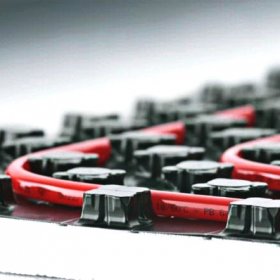
In the building materials market, various types of pipes are used for installation of heating systems, hot (domestic hot water) and cold (cold water) water supply. What are the criteria for choosing a pipe for a warm floor? When choosing a significant role is played by the cost of the material, the complexity of its installation, the duration of the life. The guarantee of the quality of the goods is the name of the manufacturer. Many consumers prefer to choose more expensive pipes of a well-known brand. After all, material from an unknown company can be fake. Most often, metal-plastic pipes and polymer pipes made from cross-linked polyethylene are used for installing underfloor heating. Of course, with the availability of funds, copper pipes can also be purchased, but at the same time, the cost of installation increases significantly. Therefore, this material is very rarely used in practice.
Each type of pipe differs in operational and technical characteristics, installation features. This video shows the installation of a polymer water floor system.
XLPE pipes
Pipes made of cross-linked polyethylene are famous for their resistance to thermal influences, which allows to increase the temperature of the coolant. High durability of products is achieved through the use of special technology in their production, the essence of which is the use of high pressure.
Cross-linked polyethylene pipes intended for the installation of underfloor heating are available in different densities. Recommended crosslink density is in the range of 65-80%. This characteristic affects the cost of the material. Polyethylene processing can be organized by several methods, namely:
- silane gas (crosslink density is 65%);
- peroxide with a crosslink density of 75%;
- irradiation in a magnetic field by an electron flux (crosslink density - 60%).
Unique fittings are used to obtain a tight seal, and the operation takes only a few seconds. A special ring is put on the end of the pipe. Then, using a tool designed to make connections, the pipe section expands. A fitting is inserted into the resulting expanded hole. Next, the pipe is tightly crimped around the fitting with a ring, and this completes the installation of the connection.
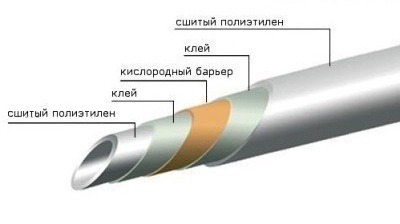
Pipes made of cross-linked polyethylene with an oxygen layer are ideal for installing a warm floor, but because of their high cost, they still lose in popularity to metal-plastic products
Plastic pipes
Metal-plastic pipes for a warm water floor are not inferior to polymer products in popularity. When heated, these pipes retain their structure, withstand significant loads, and can be used for a long service life. They are manufactured by all manufacturers in a five-layer version. In this case, three layers are the main, and two are binding (adhesive).
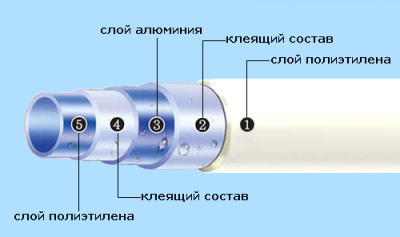
The design of the metal-plastic pipe consists of five layers marked on the section of the product. The top and bottom layers are cross-linked polyethylene. In the middle - aluminum foil, connected to a cross-linked polyethylene layer of special glue
Here is how such a pipe works:
- The inner layer, which is responsible for ensuring the operating parameters of the pipe in pressure and temperature, is made of cross-linked polyethylene by extrusion.
- Next is a layer of a special adhesive that provides a reliable connection of cross-linked polyethylene with an aluminum layer.
- For the manufacture of aluminum (gas-tight) layer is a special foil, the thickness of which, depending on the diameter and type of pipe, can vary in the range of 0.2-2.5 mm. Aluminum foil is welded along the entire length of the pipe in two ways - butt or lap.
- Then another layer of adhesive is applied, connecting the aluminum pipe to the outer protective layer.
- The top layer can be made of polyethylene (crosslinked or ordinary with a high density).
Due to this structure, metal-plastic pipes have high flexibility, shape stability after bending, which is important when installing underfloor heating systems. After all, the pipeline has to be laid in the form of snakes and spirals with a large number of turns. The light weight of the pipes greatly simplifies installation operations.
How to calculate the approximate flow rate of pipes?
When designing a warm water floor system in a particular room, it is assumed that the maximum length of a warm floor pipe can be no more than one hundred meters. One loop of water floor heating is made from a single piece of pipe. It has already been estimated that a 100-meter bay is enough for a floor area of 20 square meters. Knowing the total area of the room, you can calculate the approximate consumption of the pipe on the warm floor. When performing calculations, it is recommended to throw away areas on which it is not intended to heat the floors. This will avoid the acquisition of extra meters of pipe.
When performing the calculation, the distance that will be left between adjacent turns should be taken into account. This distance, experts call the step. The size of the step depends on the temperature in the area of laying the warm floor. The maximum step size is 35 cm. When this limit is exceeded, a person will feel a zonal difference in the floor temperature, since his surface will not be able to warm up evenly.
For the design and subsequent installation of a warm water floor system, it is better to invite specialists who will advise the best pipes and other consumables. Installation, performed by a team of professionals in accordance with the prepared project, will ensure long-term operation of the water heated floor.

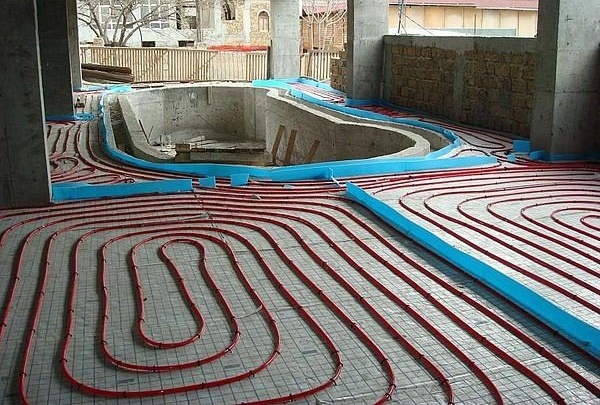
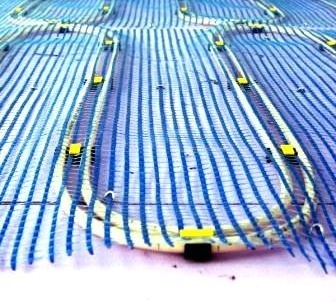
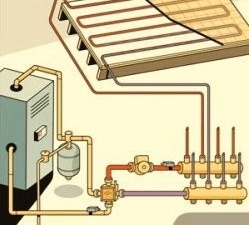
6 comments